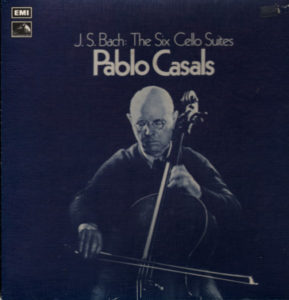
Pablo Casals Bach Cello Suites No.1-6 (Opus Kura) Rec.1936-39 OPK-2041/2.
Introduction.
Whilst I have it on good authority that earlier recordings of parts of Bach’s Suites exist, Casals is reputed to have been the first to record the complete set.
In any event he is considered the first internationally famous cellist to have undertaken the task.
He had been playing the suites since he first discovered a manuscript copy at the age of 13. As his recordings only commenced when he was 60, it is fair to say he had lived with the suites for a long time. Thus, his readings were by no means first impressions. However, without an earlier tradition to consider, he was effectively completely reliant on his own views of how they should be interpreted.
The Music.
So, what can be said about his readings? Well they seem to me to be very full blooded. They are on the whole brisk readings with some issues of intonation at times.
Occasionally, in the quicker movements (such as the Gigues), I sense he may have been playing at a speed faster than his fingers wished to fly. The consequence being slight blurring of some notes.
On the other hand, a few raised eyebrows may be caused by his interpretation of the Prelude to the 5th Suite. This is a long version by anyone’s standards. An object lesson in sustained phrases!
Despite all the above, I am happy to continue playing Casals’ recording at periodic intervals. (Even if it would never be my desert island version.)
It still seems to hang together on its own terms, and given how long he had been performing the works it deserves the deepest respect.
Furthermore, there is little doubt that his championing of the works sparked a revival of them leading to many wonderful recordings by other artists to follow, so he is owed a massive debt.
The Recording.
I can’t leave this review without addressing the issue of the recording’s age. As they were recorded in the years leading upto the Second World War technical limitations in the sound are inevitable.
Also it is impossible to get a version which completely eliminates hiss in the recordings. An inevitable result when they are being sourced from old record pressings. However, there are choices to be made here. As regards the version I have on a relatively rare Japanese label, they used USA pressings. They found Japanese pressings to be inferior and British pressings to have a larger surface noise than the American ones. Even so, they acknowledged they made limited use of digital noise reduction techniques, believing that excessive noise reduction also leads to reduction of the music available. The trade off then arising of thin and metallic sound. For sure, hiss on my version is significant and ever present. Yet I am happy to live with that for the potential gains.
Also perhaps because of its constant presence, over time I tend to zone the hiss out anyway.
My understanding is that more readily available versions from Warner/Emi and Naxos have intervened more in reducing hiss. This may suit others better. Something for the reader to explore!
Mark.